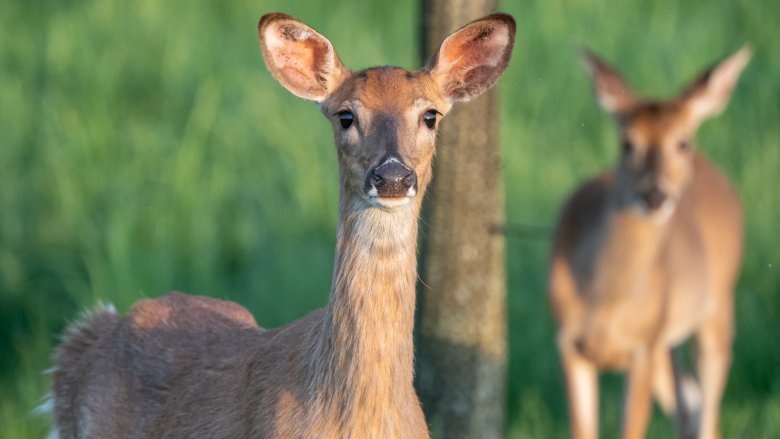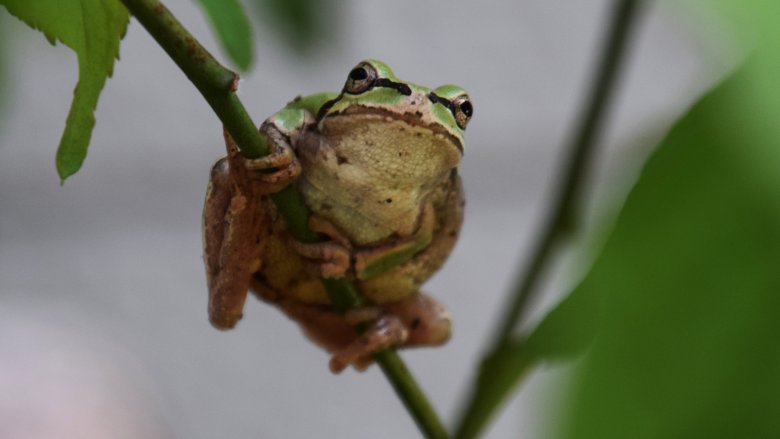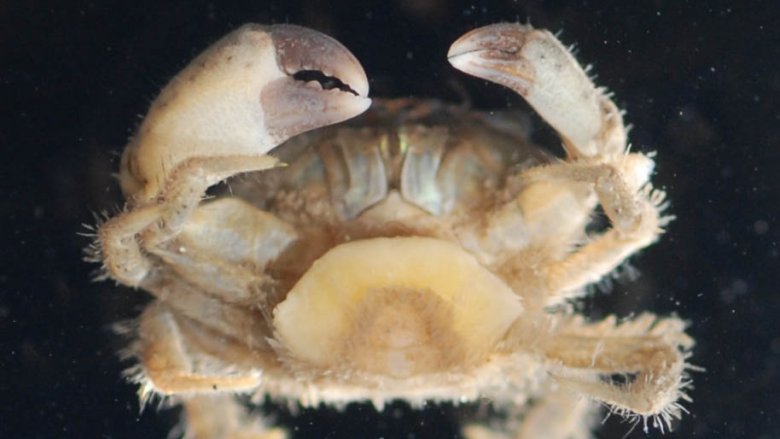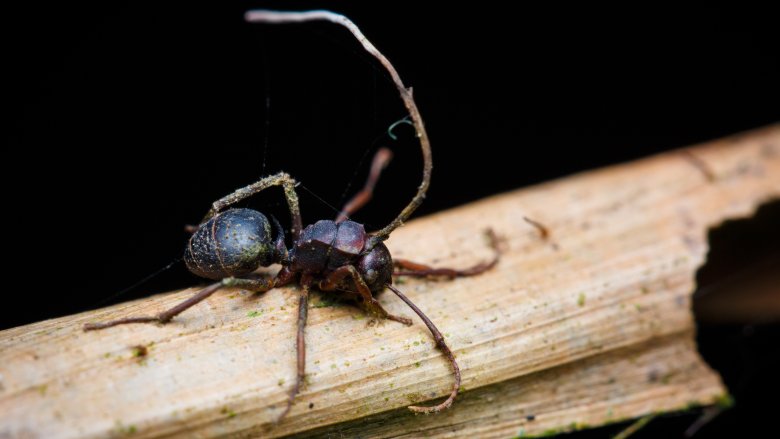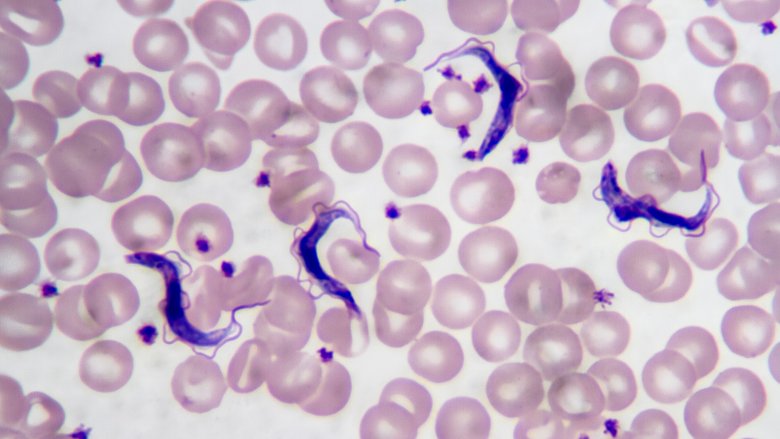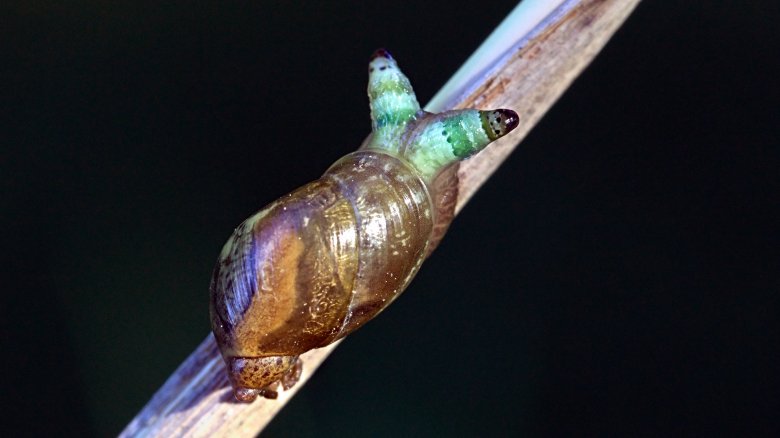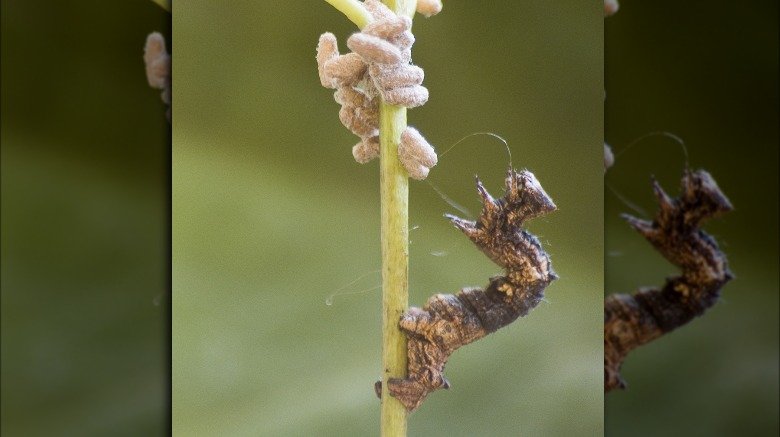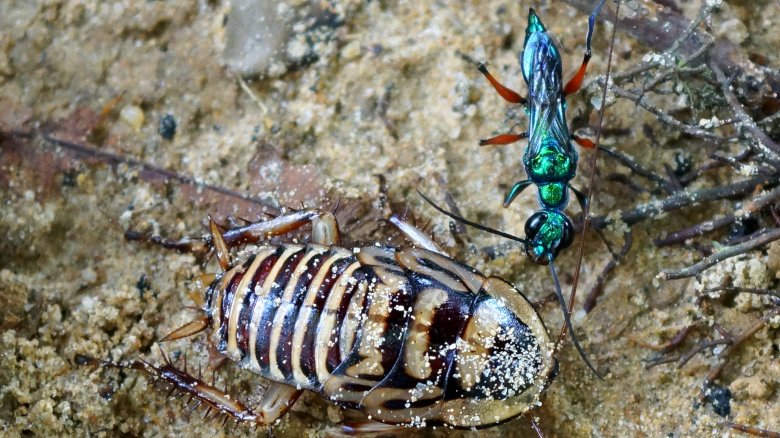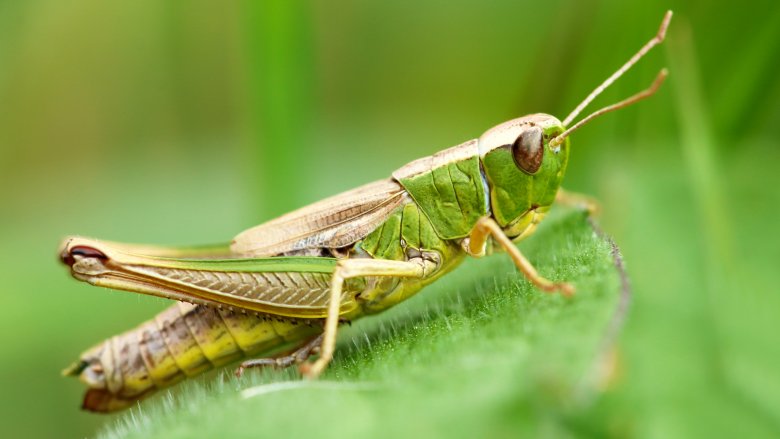Real-Life Zombies You'll Find In Nature
Zombies are pure fiction, existing solely for the entertainment of people who still watch "The Walking Dead." There is no such thing as a sickness that makes people rise from the dead or walk around with decomposing body parts or mindlessly do the bidding of a zombie-controlling overlord. Except there sort of is, which is why you're reading this.
Zombies are real, but don't build yourself that underground bunker and wipe out the beans and rice supply at your local Safeway just yet. There are only a few things that can turn humans into zombies, and they aren't spread by the teeth of other zombies. (Except rabies, but that's really more of a werewolf thing.) Most of the zombie-like stuff that exists in nature infects non-human species, and the human stuff is pretty easy to avoid. Most of the time. Still, nature is a freaking terrifying place, so only keep reading if you really think nature will never get sick of the human race's antics and devise an actual zombie virus to take us all out, or if you already have that underground bunker stocked with plenty of non-perishable proteins.
Zombie Deer
Zombie deer are extra super terrifying, especially if you enjoy a nice venison steak once in a while, or if you think Bambi is a total ruse and the world's deer are actually conspiring to become terrifying flesh-eating predators. According to the CDC, "chronic wasting disease" (also known by the much more fun name "zombie deer disease") affects deer, sika deer, elk, moose, and reindeer. Yes, even Santa's loyal team is not immune. Infected deer will stagger around, drool, stare vacantly into space, and lose large amounts of weight before eventually dying. The disease has actually been around since 1967, but as of 2021 it's been reported in 25 states and in Canada, Norway, Finland, and South Korea.
Like mad cow disease, which has killed more than 200 people worldwide reports the United States Food and Drug Administration, chronic wasting disease is caused by prions. Prions are infectious proteins that are passed throughout the deer population in bodily fluids like saliva and urine. So far there have been no known human infections, but that doesn't mean human infection isn't possible. The CDC says it's probably a bad idea to eat infected deer or elk meat, so if hunting is your thing maybe just don't shoot the ones that look like they're trying out to be extras on "The Walking Dead." If you live in an area where infected deer have been reported, you may be able to have your venison tested to see if it's safe to eat.
Sexy zombie frogs
Human zombies aren't usually sexy, with a few mostly lame exceptions. But in nature, zombie diseases are all sorts of innovative, and one that infects frogs appears to spread by making its victims more attractive to the opposite sex.
Batrachochytrium dendrobatidis is a fungus that's so deadly Science Magazine says it's actually caused hundreds of amphibian species to become extinct, and it may threaten up to one-third of all the world's frogs and salamanders (and other amphibians, too). Victims die after the fungus destroys the skin and immune system and eventually causes heart failure.
Some species have developed a tolerance to the fungus, though, in particular the Japanese tree frog. Weirdly, this frog is tolerant to the fungus (infected frogs don't usually die from the disease), and infection also appears to make the males more attractive to females. A 2011 study found that infected frogs had a different mating call than healthy frogs did — one that was faster and longer than the calls of the uninfected frogs. The longer, faster calls are more attractive to females, so when the females show up in search of a little action, the infected males pass along the fungus as well as the genes that appear to make the frogs more susceptible to infection.
So to sum up, the fungus creates hordes of zombie minions that are irresistible to the opposite sex. That sounds like the grossest "Walking Dead" episode of all time.
Zombie mud crabs
Actually, nope. This is the grossest "Walking Dead" episode of all time.
A parasitic, microscopic barnacle called Loxothylacus panopaei infects a small crab called the white-fingered mud crab, reports the Smithsonian. According to the National Resources Defense Council, the barnacle is an invasive species, brought to the region with oysters from the Gulf of Mexico during a Chesapeake Bay oyster shortage in the 1960s. Female barnacles take over the nervous and reproductive systems of both male and female mud crabs, depositing their larvae into a sac under the crab's abdomen. The infected crabs not only become infertile, but they are also compelled to protect the parasite's larvae exactly as they would protect their own offspring (even the males, who become feminized as the larvae grow). So that's kind of like if you raised a corpse and then made it into a surrogate parent for your creepy offspring. Yes, pregnant zombies. Eww.
White-fingered mud crabs aren't really important to humans — they're a small species, so they aren't ever going to show up on the menu at your favorite seafood place. But in the Chesapeake Bay, up to 90% of white-fingered mud crabs are zombified, and in the event of a population crash, the larger species that depend on them for food, such as birds, fish, and other crustaceans, could be at risk. So zombified mud crabs are something to worry about, and not just because of the pregnant zombies.
Zombie ant
The jungles of South America are filled with all kinds of terrors, and not just booby-trapped temples with ugly golden idols hidden inside them, either. As it turns out, the jungles are also full of zombies, so excavate that, Indiana Jones.
One of the most horrific jungle zombies is the zombie ant, which is infected by a fungus called Ophiocordyceps. According to Scientific American, infected Camponotini carpenter ants leave the colony and stagger around for a while until they do something really, really specific, which is totally outside of normal ant behavior. When the Sun is highest in the sky (that's not just for dramatic effect, this literally happens at noon), the ants will orient themselves in a north-northwest position and then bite down on the main vein of a leaf that is approximately 10 inches above the ground. At this point the ant's jaws have atrophied, which causes it to lock down on the leaf, where it remains until it dies.
Then, a giant stalk of fungus grows from the ant's head and rains spores onto the forest floor, where more ants pick them up and repeat the deadly cycle.
Scientists think the wandering ant thing is an important reason for the success of the fungus, since ants that die outside the colony are much more effective spore-raining devices than ants that die inside the colony. Ants always remove their dead from their living spaces, before the fungal stalk would have time to grow.
Zombie ... people
So there aren't many zombie diseases that affect human beings, right? Well, now, it's time to shatter your false sense of security. There is a real disease that turns human beings into "zombies," though it's not spread by other zombies, and its victims don't eat brains or decompose or anything.
According to the BBC, the disease is called African trypanosomiasis or "sleeping sickness," and it's spread by the tsetse fly. At first, the symptoms are like a lot of illnesses — headaches and muscle aches — but victims develop irritability, difficulty concentrating, and slurred speech, followed by loss of appetite. They stop sleeping at night and become excessively tired during the day. Eventually they lose the ability to perform simple tasks and lapse into a "zombie-like state" before finally slipping into a coma and eventually dying. Some people survive, but their brains are usually irreversibly damaged.
So if you've been planning to travel to the African continent, be prepared. There is no vaccine, and survivors don't develop immunity. There are drugs available to treat the illness, as per the CDC, but they are not widely available around Africa and are also not considered a "cure." Patients can relapse up to two years after infection.
Zombie snails
If it wasn't for the whole homicidal brain-eating thing that zombies do, they would be slapstick theater stars. Zombies are forever staggering into sharp objects, becoming incapacitated by mud, or walking off cliffs. They're terrifying, but it's not like it's especially difficult to outsmart them because besides being ravenously hungry for human flesh they also seem to be remarkably incapable of self-preservation.
Some real-life zombies are like that, too. The amber snail gets infected by a parasite called Leucochloridium paradoxum because it gets tricked into eating the parasite's eggs while it's scavenging the delicious excrement of the local bird population. The eggs incubate inside the snail, and then they hatch and infect the digestive gland. The juvenile parasite grows inside long tubes, which stretch until they fill the snail's tentacles. According to Animal Diversity, the tube-filled tentacle enlarges and then pulsates in vivid colors, basically like a neon sign that says "come eat me!" Birds see the colorful display and swoop down for a snack. The worms continue to develop inside the bird's gut, eventually laying eggs that get pooped out, and the cycle begins all over again. So basically, the parasite turns the snail into the instrument of its own demise, not unlike the zombie that walks into a pointy piece of metal.
Zombie caterpillar
You have probably heard of parasitic birds like the cuckoo, which is too lazy to raise its own young so it just leaves its eggs in someone else's nest. Some insects do the same thing, except the process is way, way more insidious and horrifying.
According to New Scientist, a wasp called Glyptapanteles lays its eggs in the body of a caterpillar. The eggs hatch and the larvae feed on the caterpillar's body fluids until they are ready to eat through the body of their host and enter the cocoon stage on a nearby twig or leaf. But they're not done with the poor caterpillar yet, which has somehow survived the whole process of being soup kitchen to some 80 wasp larvae. Instead of crawling off to die, the caterpillar stands guard over the cocoons. And like any good zombie, it will actually lash out violently at anything that comes near its creepy little offspring. Then, it conveniently dies right around the time the young wasps emerge from their cocoons.
No one really knows how the parasite manages to turn the animal it's killing into a devoted bodyguard. A couple of larvae do stay behind inside the host caterpillar while the rest of their siblings are pupating, but unless there are levers and pulleys in there somewhere it's really not clear how the actual mind control part of the process happens. That sort of makes the whole cuckoo thing look pretty benign, doesn't it?
More zombie people
If you're looking for stories of real-life human zombies, your search is likely to take you to Haiti, where there are voodoo priests who can turn human beings into zombies — or so the legends say. According to Harvard Magazine, there's a well-documented case from 1980 of a man who claimed he'd been resurrected by a voodoo priest and then enslaved on a sugar plantation. His death was actually recorded and confirmed, but he said he could remember all of it, from the moment he'd been pronounced dead to his actual burial and "resurrection."
This sounds terrifying and also totally fictional, but a Harvard ethnobotanist who investigated Haitian zombies in the 1980s discovered that voodoo practitioners were using "zombie powder," a poison that slows metabolism until victims appear to be dead. One of the key ingredients of the powder was the toxin of the fugu puffer fish, which is a Japanese delicacy that has to be specially prepared so it doesn't poison the person eating it. Victims of fugu poisoning experience almost exactly the same symptoms as the Haitian "zombies," including paralysis and consciousness during the perceived "death" state.
Fugu poisoning — if you survive it — wears off on its own, but zombified Haitians were also manipulated into believing they'd lost their free will. They may even have been fed different poisons to keep them in a state of complacency. So there you go, potential actual zombies that are really similar to the ones from your nightmares. You're welcome.
Bacteria that only makes you look like a zombie
So far none of these natural zombie phenomena have involved decomposition, but nature even has its own version of that one. It's called necrosis, and Science Daily says it's the "unprogrammed death of cells and living tissue." The "unprogrammed" part of that definition is key — in programmed cell death, the immune system cleans up cell debris, but when there's necrosis the immune system doesn't get the signals that let it know there are dead cells that need to be eliminated. So a person who has necrosis is basically decomposing while still alive.
Necrosis can happen after an injury, notes Britannica, when there is limited blood supply to the injured area or when there's a bacterial infection. The venom of some spiders, like the brown recluse, can also cause necrosis.
Before you decide to never again leave your house and just mail order everything, though, it's worth noting a couple of things about necrosis. It's typically localized (at least at first), so it can be treated and the spread can be halted well before you'll be scary enough for a "Walking Dead" cameo. And the super-scary bacterial version (necrotizing fasciitis) is really uncommon. Most experts think it affects maybe 1 to 5 in 100,000 people, although those numbers don't take into account all the bacteria that can cause necrotizing fasciitis. It's not a huge risk, but you maybe don't want to spend a whole lot of time thinking about it, just the same.
Zombie roaches
The insect world seems to have the majority of real-life "Walking Dead" stories, and just like your favorite characters in the AMC series, not all zombie victims will go down without a fight. The jewel wasp, for example, turns cockroaches into zombies. Now just setting aside the fact that cockroaches totally have it coming, the zombification process is still pretty horrific. The female jewel wasp stings the cockroach twice, details Science News. First, it paralyzes the roach's front legs, then it delivers venom directly to the roach's brain. (Yes, weirdly, roaches do have brains.) The second sting makes the roach complacent, only able to walk if it's being led. By the wasp.
So then, the roach's attacker leads it around like the world's most unfortunate dog, lays an egg on it, and buries it alive. You can guess what happens next — the egg hatches, the larva burrows into the cockroach's body, eats it from the inside out, and then emerges from its dead host.
According to Science News, a healthy roach would dig itself out of its grave, but the zombified roaches don't even try. Sometimes, though, the cockroaches will fight back against the wasp's initial attack. In the lab, some roaches were able to fend off the wasp for up to three minutes. Scientists think in the wild that would probably be enough to convince the wasp to look for another victim. Next, scientists expect the roaches to arm themselves with tiny baseball bats studded with nails. Just kidding.
Zombie grasshopper
If you were a zombie, you might be just hoping for death. Faced with the prospect of either jumping into a lake or eating raw human brains and having body parts randomly fall off you as you decompose, what would you do? For zombified grasshoppers, the answer is simple. It's exactly what their zombie overlords want them to do, but it beats the alternative.
The Nematomorph hairworm is a parasite that infects grasshoppers and crickets. The adult hairworm is aquatic, which presents it with a slight problem because grasshoppers and crickets are not aquatic. What to do? How about brainwashing your unwitting nanny into drowning itself. That should work.
According to New Scientist, after the hairworm matures, it needs to swim away and find a mate. But first it needs to get its host into the water, and it does this by producing proteins that affect the grasshopper's central nervous system. The proteins change the grasshopper's response to water, as per the Proceedings of the Royal Society, which ultimately makes it more likely to jump into a large pond, swimming pool, or whatever water-filled environment happens to be nearby. Then the worm leaves its host and lives happily ever after. Yay.

